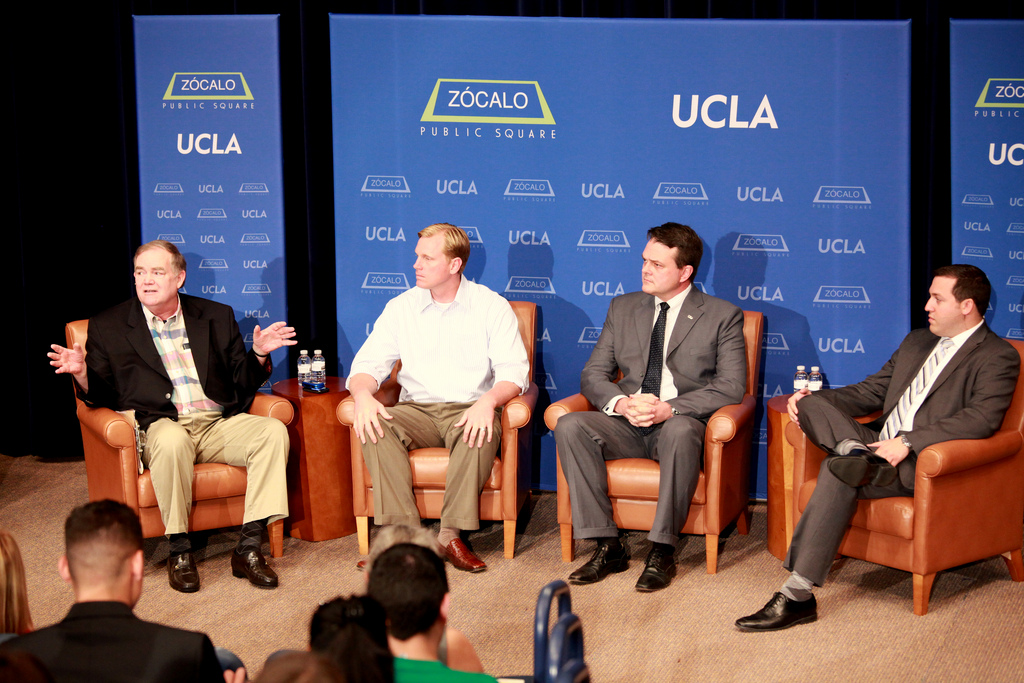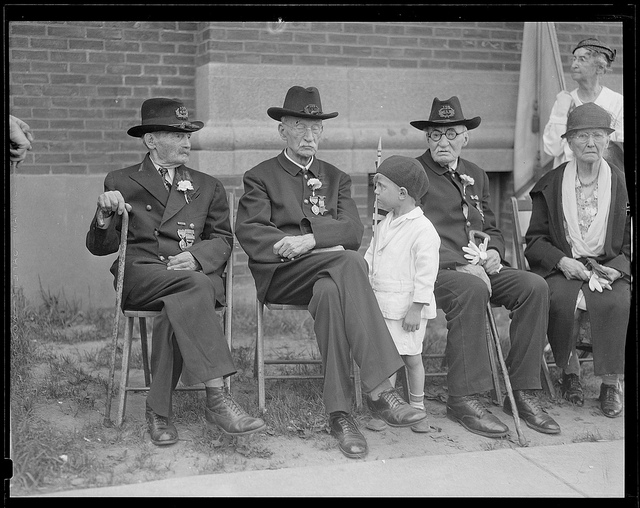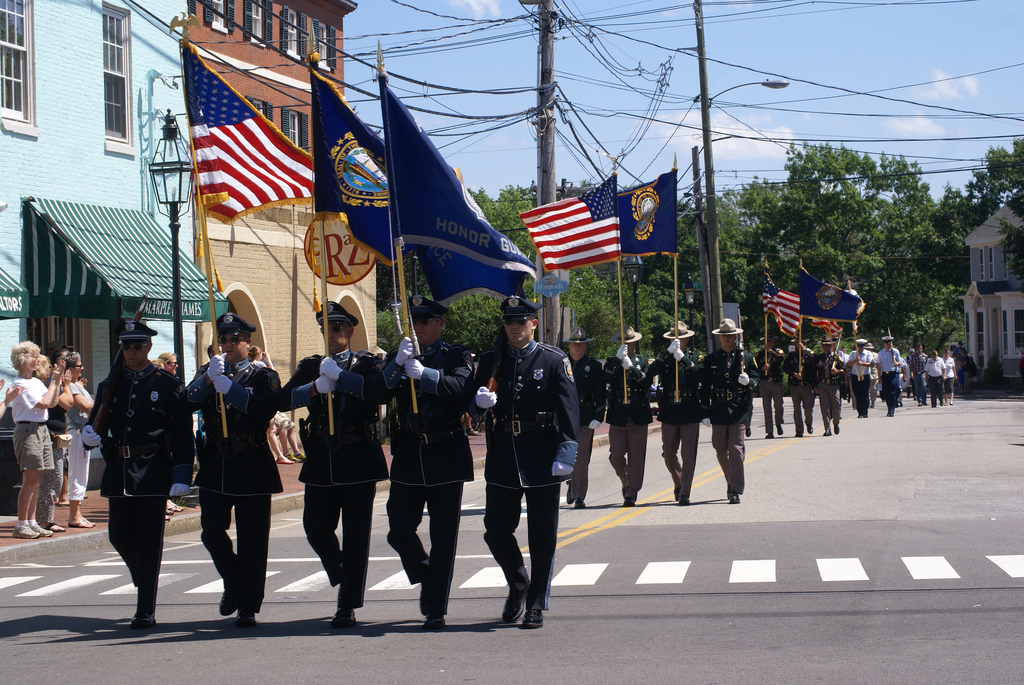
The 2 million veterans who are returning home from Iraq and Afghanistan have had their lives changed by war. As they come home, they have the potential to change the lives of civilians, too. At a Zócalo/UCLA forum at UCLA’s De Neve Auditorium entitled “How Are Veterans Changing America?”, three panels discussed the impact veterans are having on America’s economy, medicine, and families. In a special address to the gathering, Congresswoman Tulsi Gabbard—a representative from Hawaii who served two tours of duty in the Middle East—talked about what she thinks veterans can do for the nation, as well as what we can do for them.
Why Don’t We Hire More Veterans?
“What we’re here about today,” explained Tony Perry, San Diego bureau chief of the Los Angeles Times, “is a classically American issue: how to integrate the American warrior back into society when the war is over.”
Readjusting to post-war life has been a challenge faced by Americans since the Revolutionary War, a challenge faced in similar form by most human societies. Traditionally, though, the warrior has always found his own way back. So, Perry asked three veterans of Iraq and Afghanistan who hire and train veterans to enter the civilian job market, “Why not let it happen naturally?”
“It’s not a natural process,” said panelist Colin Archipley, CEO of Archi’s Acres and Veterans Sustainable Agriculture Training. What’s more, the veteran must now contend with society’s prejudices, a widespread view of “the war fighter as a victim, as opposed to a person who overcame major challenges.”
Jim Cragg, founder of Green Vets Los Angeles, echoed the point. “The veteran is being seen as a victim, rather than a leader,” Cragg said. “Our country needs leadership, and we have this amazing group of people who served their country.”
Raymond Toenniessen, director of new initiatives at the Institute for Veterans and Military Families, agreed with his two co-panelists, but he noted that employers need to hear a more sophisticated pitch for hiring. “Everybody has played the card of ‘vets are leaders, they show up to work on time, they’re disciplined,’” Toenniessen said. But Toenniessen prefers to stress the other bottom-line-enhancing qualities of vets: “Vets are entrepreneurial, they think outside of the box, they’re drivers to success.”
Perry suggested to the panelists that one obstacle for the returning soldier is that he or she understands work in a very specific way that’s hard to transfer, except into something like police work. Moreover, veterans are used to the routines and structures of a government job—and the private sector is different.
Cragg said to Perry, “You’re dead on, but there are two sides to that.” Yes, it can be tough for “guys with big egos” who are used to being worshipped by everyone to get used to an ordinary desk job. But in many respects, the military is ahead of private industry in its approach to process, ethics, and leadership. Soldiers are “learning some bad habits, but they’re also learning some great habits. “
Archipley stressed how improvisational and entrepreneurial day-to-day military work is, drawing on his own experiences as a Marine in Iraq. “We had to create new counterinsurgency doctrine,” he said. “It was us—20-year-olds and 22-year-olds.”
Toenniessen said much of making a successful transition to private employment came down to “expectation-setting on both ends: on service members and the employer.” You may be getting a “phenomenal employee,” Toenniessen said, but that employee will require training and some adjustment. As for veterans, they have to recognize that often they’ll be taking a step down. That can bruise the ego, but Tonniessen usually finds that “three years later they’ve far exceeded their non-vet peers.”
One problem pointed out by panelists was a perceived stigma against hiring veterans—that it’s considered an act of charity. Cragg said that a CEO colleague had suggested to him that his business was overly reliant on veterans, causing it to be less creative or dynamic. “I hold 12 patents, we have over 1600 designs,” Cragg said. Veterans are plenty creative and dynamic.
How Are The Wars Changing Medicine?
Veterans returning from the nation’s recent wars are transforming the practice of medicine across dozens of specialties, resulting in better care for us all, agreed a panel of doctors.
In a wide-ranging conversation moderated by veteran and USA Today reporter Kelly Kennedy, the doctors—VA Greater Los Angeles Healthcare System chief of staff Dean Norman, Operation Mend co-director Kodi Azari, and UCLA Brain Injury Research Center director David Hovda—said that the treatment of military service members injured in these wars had changed not only the technical work of fixing tissue and bones and faces but also the methods of managing care and communicating with patients.
They also cautioned that, because of the new nature of these wars and the ability of service members to survive injuries that killed previous generations of warriors, much remains unknown.
The wars in Afghanistan are the first in which service members who lost all four limbs have been able to survive, said Dr. Azari, a plastic surgeon. And because IEDs often contain body parts, feces, and other materials that cause infections, medical specialists have struggled to keep up with new drug-resistant infections, Azari added. Hovda noted that better equipment, such as helmets, had changed the nature of the injuries seen in these wars.
In order to heal these injuries and others, the medical profession is making advances in engineering tissue, prosthetics, treating brain injury, handling burns, and all aspects of emergency medicine. The doctors noted that the treatment of victims of the Boston Marathon bombings had benefited from the knowledge gained from treating service members in bombings in the theater of war.
The medical profession has had to adjust in many ways. Norman said that one difficulty for the VA was dealing with so many young military service members who have been injured. “We weren’t set up to deal with a large number of young people,” who often expected speedier care and were far more comfortable with technology than previous veterans. The VA also is doing more to treat sexual assault in the military (the prevalence of which Norman called “a national disgrace”) and to develop “psychosocial support” structures for veterans and service members in treatment.
One reason for the advances, the doctors suggested, is that veterans and service members make good patients; they know how to follow directions, are good at reporting back, and are incredibly dedicated to their treatment. Hovda also said that the military had responded to the problems caused by concussions years faster than the National Football League.
Norman repeatedly urged veterans to be screened by the VA (he also said he supported legislation to require such screenings) because many veterans may have injuries of which they are not aware.
Azari said that treating service members has changed his thinking about medicine, and the capacity of the human spirit, more than anything. “I have learned not to judge based on the injury,” he said. “I don’t know what that person’s capabilities are. I’ve found their capabilities are enormous despite having severe wounds.”
Hovda said the wars had shown the truth of the maxim that “the only victor in war is medicine.” But he couldn’t remember who said it. Dr. Azari replied: “It was the Mayo brothers,” William and Charles, who founded the Mayo Clinic.
How Do Wars Affect Families?
For military and veteran families, fostering resilience isn’t a choice but a necessity. Deployment, said panelist Megan Glynn, whose husband has been deployed five times—and who currently serves as deputy director of Blue Star Families, an organization that connects military families in order to help them support one another—doesn’t get any easier over time. After your first deployment, she said, you know just how difficult the experience will be on you and your children. And although you know you’ll get through it, you’re not quite sure how.
New York Times reporter Patricia Leigh Brown, the panel’s moderator, asked the panelists what, if anything, is different about this war’s effect on families as opposed to previous wars.
Child and adolescent psychiatrist Patricia Lester, director of UCLA’s Project FOCUS, which offers resiliency training for military families, said that Glynn’s experience demonstrates the difference. This war has been so long, and is fought by such a large professional military, that many children age 12 and under have spent their entire lives saying hello and goodbye to their parents. They live with worry that they don’t necessarily know how to express.
Psychiatrist Judith Broder, founder and director of The Soldiers Network, which offers free therapy to veterans and their families, said that in the Iraq and Afghanistan wars, about half the people who are deployed are in the Reserve or the National Guard—which means they don’t have the support and network of families who live on bases. “The stress on these families, who are hidden among us, I would say, can be extreme,” she said.
Military children, said Lester, tend to do better than civilian kids by a number of measures, despite the fact that they move six to nine times between starting kindergarten and finishing high school. But we can do more to help them feel less isolated and alone.
Brown asked whether the panelists have found that service members—a notoriously stalwart lot—are reluctant to seek help for their mental health.
Broder and Lester said that they were warned that veterans would not want to talk about their feelings, but they’ve found them to be remarkably willing to work at keeping their families together. Nonetheless, it’s difficult to transition from being at war to reconnecting with a spouse and children who have an entirely different set of daily concerns.
Glynn said that she and her husband have found that setting rules before he returns home is helpful. For instance, they’ve agreed that in his first two weeks back, her husband can’t make any judgments about how she’s parenting. Their children have grown older, and the same discipline that worked when he left doesn’t work now. The family has had to adjust in his absence, and it needs time to adjust back. “The homecomings they show [on television and in film] are so romantic and so happy,” she said. “It’s romantic for a very short time, and then it’s more laundry to do,” real meals to cook—and “a very difficult transition.”
The next transition for military families could be even more difficult, as the wars end and service members no longer have a next deployment on the horizon.
Glynn, who played soccer as a student at UCLA, likened being in the military without going to war to practicing without playing a game.
Added Broder, to live a life without meaning or purpose is terrible—and she thinks this is part of the reason why so many veterans commit suicide. “They haven’t found service,” she said.
So what, asked Brown can we do to help?
“It has to be a partnership between veteran families, military spouses, and all of us in the community,” said Lester. We need to train our communities to understand service, and the needs of military families—to be aware of them—in order to be able to support them.
Congresswoman Tulsi Gabbard Delivers a Keynote
Before introducing featured speaker Congresswoman Tulsi Gabbard, UCLA Chancellor Gene Block pointed to a number of innovative programs across disciplines—many of which were represented by the day’s speakers—that demonstrate the university’s commitment to serving veterans.
A standing ovation greeted Gabbard, who opened her talk by explaining that she wasn’t going to talk about the challenges veterans face coming home but “about the great contributions veterans bring to our community, and what that service really means.”
Gabbard was already familiar with “service” when she joined the Hawaii National Guard in 2003; she had just been elected to the state legislature. But she felt a need to extend that service beyond her constituents. Being deployed to the Middle East offered her that opportunity as well as the perspective that comes with putting your life in danger every day. She recalled going through lists of casualties as well as a sign in her camp in Iraq that read, “Is today the day?”
On the home front, Gabbard has talked about helping veterans finding jobs, about challenges like PTSD. She thinks the solution to a lot of these challenges is to encourage veterans to continue service at home—to show them that the skills they’ve learned have value beyond the battlefield. “That not only helps veterans continue with that purposeful life, continue that service,” she said. “But imagine how much benefit we get as a country, as a community.”
This will require a lot of different organizations, institutions, and people to work together—and to open their eyes, said Gabbard, to the reality of a country that’s been at war for over a decade. It’s been easy to go about our lives without remembering that we’re still at war. But our troops continue to put their lives at risk—and we have a responsibility to them.
I hope, concluded Gabbard, that conversations like today’s will inspire people to look in the mirror and ask what they’re doing for veterans—and to decide that it’s time to make a positive impact on the lives of others. That’s the key to success for our entire country. “What better leaders than veterans who have already made that decision than to empower them to carry us forward?”






Send A Letter To the Editors